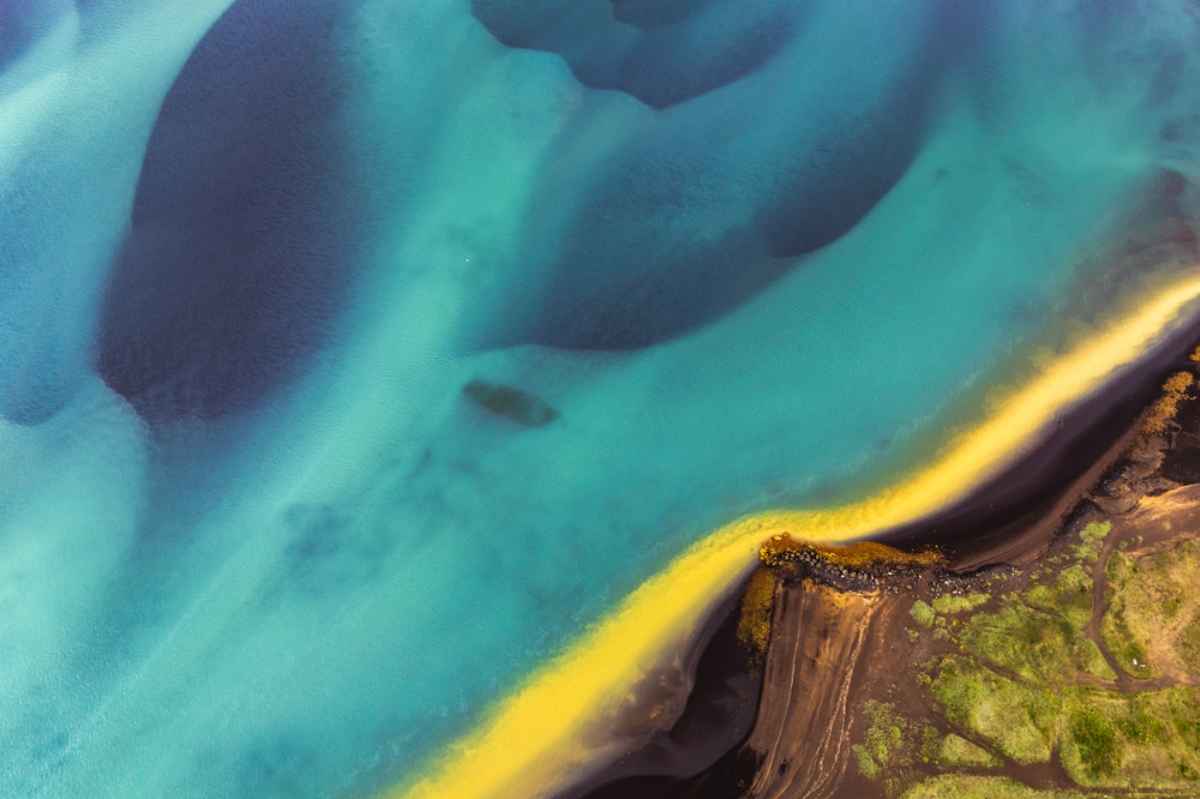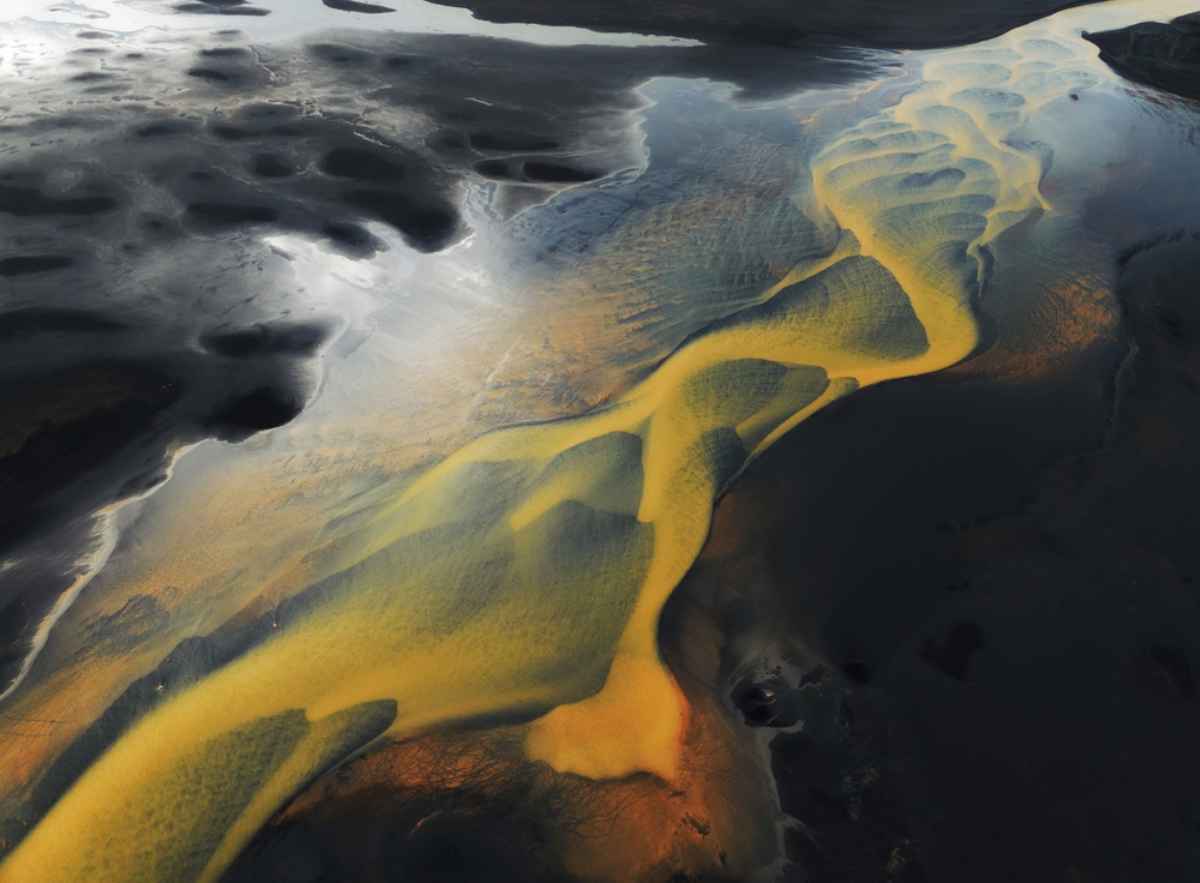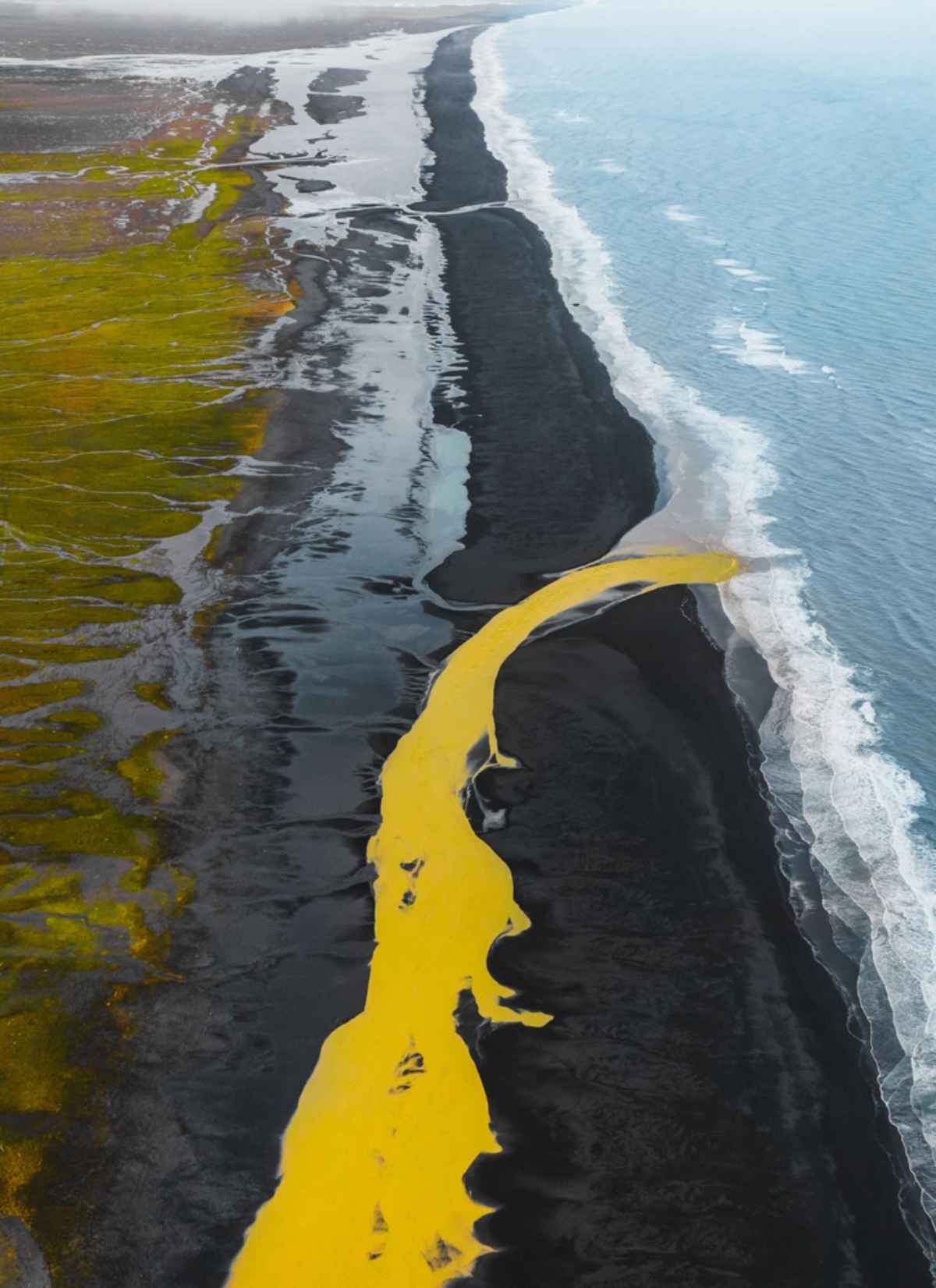Iceland is a treasure trove of contrast and natural beauty at every turn. Visitors often scour the Internet, looking for the best places to see on their vacation. The yellow river in Iceland often attracts a lot of attention, but where is it, and how do you get to it with your rental car in Iceland? The following will guide your journey so you can enjoy this unique sight for yourself.
What Is the Yellow River in Iceland?
The so-called Iceland yellow river is a natural phenomenon in Iceland. There is no official "Yellow River" in Iceland. It's actually a rare natural phenomenon—glacial runoff that, under the right conditions (such as mixing with mineral sediments), can take on a striking yellow hue. Although the runoff isn’t always yellow, if you can catch it when it is, you will be rewarded with the beautiful contrast of a black beach and a yellow river. But what is the yellow river in Iceland?
Why Is the River Yellow? The Geological Science Behind the Color
The reason for the yellow river on the black sand beach in Iceland is due to the volcanic terrain and the sulfur that makes its way into the river at certain times of the year. The volcanic landscape in Iceland is unlike anywhere else, creating natural phenomena you may not experience elsewhere.
According to a study by the University of Iceland’s Institute of Earth Sciences, the yellow tint in some Icelandic rivers is due to high sulfur and iron concentrations typical of volcanic activity. During certain times of the year, enough of this sulfur-rich sediment washes down river, creating its yellow appearance.
Where Is the Yellow River and Black Beach Located?
The short answer? We don’t know for sure—and that’s part of the magic. This so-called "Yellow River" isn’t on any official maps, nor does it have a fixed location. In fact, it’s not even a permanent river. It appears only occasionally on Iceland’s South Coast when glacial runoff carries mineral-rich sediments, creating a striking yellow hue under the right conditions.
Where does it happen? That’s the mystery. Sometimes near places like Vík or Sólheimajökull, but there are no guarantees. Even Icelanders describe it as a fleeting phenomenon—shifting locations or disappearing for years at a time. So, if you’re lucky enough to witness it, consider it a rare gift from nature.
Approximate Coordinates and How to Reach It
The yellow river can be found in Vatnajökull National Park and is formed from runoff from the nearby glacier. You will find the yellow river in Iceland near Ingólfshöfði, halfway between Skaftafell and Jökulsárlón. From the Ring Road, you can take a small gravel road toward the south. This road leads to the Ingólfshöfði lighthouse (63.821878251601774, -16.621044811932332), where you can get views of the black sand beach and yellow river.
Iceland Green Fields, Yellow River, and Black Beach
The reason for the popularity of the yellow river and black beach in Iceland is because of the striking color contrasts. In addition to the yellow river against the black sand beach, you will also find lush green fields leading up to the black sand, bringing together an impressive landscape that looks fantastic in pictures.
Best Time to Visit the Yellow River
If you don’t know when to visit the yellow river in Iceland when it is the proper color, you may find yourself disappointed with the experience. Because the conditions in Iceland change often, you must time your visit well to ensure you can see the sharp color contrasts in the area.
Ideal Seasons and Lighting for Photography
Because the yellow river is primarily glacier runoff, it’s important to visit it at the right time to guarantee the optimal experience. In general, it is better to plan for a late spring or early summer trip when runoff is at its highest.
Visiting during the day when the sun is high in the sky will give you the best lighting for your pictures. If you visit when the sun is lower on the horizon, you may not be able to capture the true essence of the contrasting colors. Keep in mind that you will likely need a drone to capture images similar to what you have seen online.
Weather and Accessibility Tips
As with any location in Iceland, whether you can access the place in Iceland where the yellow river and black sand meet depends on the weather. Before starting your drive, check the Icelandic Met Office website for the current weather conditions. Because the road leading to the lighthouse is a gravel road, you will need the right weather conditions to drive it safely.
The gravel road isn’t an F-road, so you won’t necessarily need a 4x4 with good clearance to drive it. It’s not advised to drive this route in the winter unless you have a properly equipped vehicle. The road can also be muddy in the spring.

How to Get There: Renting a Car for the Ultimate Experience
While you may find some tours that include Ingólfshöfði, including the local puffin tour, renting a car can give you a better experience. You will be in control of how long you stay in the area and what you get to see, along with additional stops along the way.
Why Self-Driving Is the Best Option
Self-driving to the yellow river in Iceland is often the best option to ensure you get the most out of your experience. Tours often stay for a limited time, leaving you less time to enjoy the sights. Renting a car gives you greater flexibility in where you go, how much you can see, and how long you stay.
Recommended Rental Car Types for This Route
When planning a visit to the yellow river in Iceland, you should consider the type of vehicle you have. While it is located down a standard gravel road, it is often best to drive it with a 4x4 to reduce the risk of damage to the vehicle. A 4x4 campervan can also work well for this drive.
Road Conditions and Driving Tips for the Region
The yellow river and black sand beach in Iceland are located in the southeast quadrant of the country. In general, the Ring Road is well-maintained throughout the year, although there can be periods where parts of it are closed due to the weather. As long as you pay attention to the weather forecast and road conditions, you can stay safe.
Once you leave the Ring Road to head toward the yellow beach in Iceland, you will need to drive carefully. Gravel roads require driving more slowly and paying close attention to avoid potholes and other issues with the road.

What to See Nearby: Make the Most of Your Trip
In addition to the Ingólfshöfði lighthouse, you can visit other locations nearby to make the most of your trip. When self-driving in Iceland, you can create the perfect itinerary that checks off all your boxes.
Black Sand Beaches You Can Visit on the Same Trip
The black sand beaches in Iceland are one of the main attractions. If you are coming from Reykjavík, you will pass the popular Reynisfjara black sand beach. Those who are driving from the east or are continuing in that direction can stop at Breiðamerkursandur, otherwise referred to as Diamond Beach, where the glacial ice washes up on the black sand beach.
Other Attractions Near the Yellow River
If you’re looking for other things to do near the yellow river in Iceland, you will find many options in the nearby area. To the east, in addition to Breiðamerkursandur, you can visit Jökulsárlón, where pieces of the glacier break off and float to sea.
When heading toward the west from the yellow river, Skaftafell National Park offers plenty to see and do. The park features numerous hiking trails to waterfalls like Svartifoss. You can also hike to the glacial outlets. If you are traveling in a campervan, you can stay in the campground at Skaftafell for a picturesque location.
Suggested Itinerary for a One-Day or Two-Day Road Trip
Whether you’re starting from Reykjavík, Vik, or another southern town, you will pass numerous sights along the South Coast. As you travel toward the east, consider stops like Reynisfjara, Dyrhólaey, Fjaðrárgljúfur, and Skaftafell before continuing on to the yellow river in Iceland. If you still have time or wish to spend a second day, add Jökulsárlón and Breiðamerkursandur, continuing on to Höfn.

Travel Tips for Visiting the Yellow River Safely
Staying safe is essential, no matter where you go in Iceland. If you have the yellow river and black sand beach on your itinerary, here’s what you need to know about staying safe during your visit.
Be Cautious in Geothermal Areas
Although the area where the yellow river meets the black sand isn’t specifically a geothermal area, because the yellow coloring comes from sulfur, it’s necessary to be cautious. The fumes from the sulfur can be quite strong. If possible, stay upwind from the fumes to ensure a safe visit.
Stay Updated on Weather and Road Closures
Before starting any road trip in Iceland, especially when self-driving, it’s vital to check the weather and road conditions. However, it’s not always enough to check them first thing in the morning. It is often advised to check them periodically throughout the day, especially if you are traveling in the winter. Always use Icelandic sources for the most reliable information.
Why the Yellow River Is Still a Hidden Gem in Iceland
Pictures of the yellow river in Iceland frequently circulate among online resources, but many people don’t know where it is and thus don’t visit it. Despite its popularity, the yellow river and black sand beach remain a hidden gem that few people add to their itinerary.
A Unique Natural Wonder Not in Most Travel Guides
Many visitors to Iceland read blogs, join online travel groups, and purchase travel guides to help them plan their journey. Self-driving in Iceland gives you greater flexibility and endless possibilities. However, the yellow river in Iceland doesn’t appear in most travel guides, leaving it a lesser-known destination for many visitors.
Iceland is filled with unique formations and sights that can leave visitors in awe. The unique combination of Iceland’s green fields, yellow river, and black sand beach creates a breathtaking sight that you can’t expect to see in many other places. This makes the yellow river in Iceland an excellent addition to any itinerary.
Perfect for Travelers Looking for Off-the-Beaten Path Adventures
While many visitors are happy to visit the most popular sights in Iceland, there are others who prefer off-the-beaten path locations. If you’re looking for some unique sights where you are likely to encounter fewer tourists, the yellow river can be the perfect solution. The area isn’t challenging to reach, but it is often easily passed as visitors drive along the Ring Road.
Travelers interested in adding a hidden gem to their itinerary can enjoy the breathtaking views of the ocean from the Ingólfshöfði lighthouse, along with the chance to see the yellow river against the black sand if the conditions are just right.
Plan Your Trip to the Yellow River Today
Are you interested in visiting the yellow river in Iceland during your self-drive journey? When you rent a car in Iceland, you can go to locations that many tours don’t visit, giving you a more personalized experience that reflects your preferences more accurately than any tour can.
Find the Perfect Rental Car for Your Adventure
The first step is to choose the ideal rental car to help you reach every destination on your itinerary. Although a 4x4 isn’t always necessary, especially if you are traveling in the summer and plan to stick to the main roads, renting one can open up more opportunities for destinations that may be more secluded and off the beaten path.
Another consideration is whether you want to stay in hotels, guesthouses, or hostels or want to save money by camping around Iceland. Renting a campervan is often slightly more expensive than a car, but it can save you money on accommodations.
Combine Your Visit with Iceland’s Iconic Attractions
A visit to the yellow river in Iceland is an adventure in itself, but it’s in the perfect location close to Vatnajökull National Park to add other sights to your itinerary. Whether you choose to take a glacier hike or an ice cave tour, hike through Skaftafell National Park, or take in the sights around Jökulsárlón, you’ll be able to create an iconic itinerary in the southeast of Iceland.























